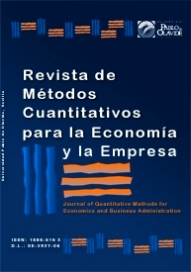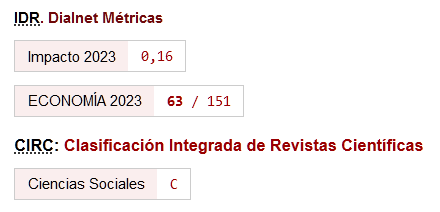Dinámica de los precios de la vivienda a raíz de la Ley de Empleos y Reducción de Impuestos de 2017
DOI:
https://doi.org/10.46661/rev.metodoscuant.econ.empresa.8487Palabras clave:
dinámica del precio de la vivienda, recortes de impuestos, estudio de eventosResumen
La Ley de Empleos y Reducción de Impuestos de 2017 (TCJA) cambió la política fiscal en dos aspectos importantes. Limitó las deducciones fiscales estatales y locales (SALT) a 10.000 dólares y redujo las tasas impositivas marginales en la mayoría de los tramos de ingresos. En este análisis, estimo modelos de series temporales de precios de la vivienda para 20 ciudades de EE. UU. utilizando datos de Case-Shiller y pruebo las rupturas de las series cuando se adoptó e implementó la TCJA. El propósito es probar si existe una raíz unitaria con puntos de interrupción en cada serie. De ser así, el shock de la TCJA fue permanente, no transitorio, y el proceso de series temporales no significa revertirse. Los resultados revelan rupturas significativas en 12 de los 20 índices de ciudades. Además, hay importantes puntos de ruptura en 22 de las 48 pruebas en todos los niveles de precios de las ciudades (16 ciudades con tres niveles de precios de la vivienda cada una). La fecha de interrupción modal es el mes de la aprobación de la legislación TCJA con otros 13 puntos de interrupción importantes dentro de los seis meses posteriores a la adopción de la TCJA. Los resultados indican que la TCJA se asoció con un efecto negativo inicial sobre los precios de la vivienda en muchos mercados inmobiliarios y niveles de precios. Es importante destacar que la presencia de procesos de raíz unitaria indica que la dinámica de los precios de la vivienda es más variable posteriormente.
Descargas
Citas
Anderson, John E., Jeffrey Clemens, and Andrew Hanson. (2007). Capping the mortgage interest deduction. National Tax Journal, 60(4), 769-85.
https://doi.org/10.17310/ntj.2007.4.05 DOI: https://doi.org/10.17310/ntj.2007.4.05
Bourassa, Steven C., Martin Hoesli, and Elias Oikarinen. (2019). Measuring house price bubbles. Real Estate Economics, 47(2), 534-563.
https://doi.org/10.1111/1540-6229.12154 DOI: https://doi.org/10.1111/1540-6229.12154
Bourassa, Steven C., and William G. Grigsby. (2000). Income tax concessions for owner-occupied housing. Housing Policy Debate, 11(3), 521-46.
https://doi.org/10.1080/10511482.2000.9521377 DOI: https://doi.org/10.1080/10511482.2000.9521377
Damen, Sven, Frank Vastmans, and Erik Buyst. (2014). The long-run relationship between house prices and income reexamined: The role of mortgage interest deduction and mortgage product innovation. KU Leven Discussion Paper No. 14.09.
https://doi.org/10.2139/ssrn.2429264 DOI: https://doi.org/10.2139/ssrn.2429264
Dickey, David A. and Wayne A. Fuller. 1979. "Distribution of the estimators for autoregressive time series with a unit root." Journal of the American Statistical Association 74(366): 427-431. DOI: https://doi.org/10.1080/01621459.1979.10482531
https://doi.org/10.2307/2286348 DOI: https://doi.org/10.2307/2286348
Enders, Walter. (2004). Applied Econometric time series, Second edition. Hoboken, NJ: John Wiley & Sons Inc.
Escobari, Diego, Danian Damianov and Andres Bello. (2012). A time series test to identify housing bubbles. Munich Personal RePEc Archive, MPRA Paper No. 44360: http://mpra.ub.uni-muenchen.de/44360/
Eviews. (2019). Unit root tests with a breakpoint. http://www.eviews.com/help/helpintro.html#page/content/advtimeser-Unit_Root_Tests_with_a_Breakpoint.html
Glaeser, E.J., J. Gyourko, and R. Saks. (2005). Why have housing prices gone up? American Economic Review, 95(2), 329-333.
https://doi.org/10.1257/000282805774669961 DOI: https://doi.org/10.1257/000282805774669961
Glynn, John, Nelson Perera, and Reetu Verma. (2007). Unit root tests and structural breaks: A survey with applications. Journal of Quantitative Methods for Economics and Business Administration, 3(1), 63-79.
Green, Richard K., and Kerry D. Vandell. (1999). Giving households credit: How changes in the U.S. tax code could promote homeownership. Regional Science and Urban Economics, 29(4), 419-44.
https://doi.org/10.1016/S0166-0462(99)00005-8 DOI: https://doi.org/10.1016/S0166-0462(99)00005-8
Haldrup, Niels, Robinson Kruse, Timo Terasvirta, and Rasmus T. Varneskov. (2012). Unit roots, nonlinearities and structural breaks. CREATES Research Paper 2012-14. Department of Economics and Business, Aarhus University, Denmark.
https://doi.org/10.4337/9780857931023.00009 DOI: https://doi.org/10.4337/9780857931023.00009
Herranz, Edward. (2017). "Unit root tests." Wiley Interdisciplinary Reviews: Computational Statistics. Available at: Unit root tests - Herranz - 2017 - WIREs Computational Statistics - Wiley Online Library
https://doi.org/10.1002/wics.1396 DOI: https://doi.org/10.1002/wics.1396
Himmelberg, Charles, Christopher Mayer, and Todd Sinai. (2005). Assessing high house prices: Bubbles, fundamentals, and misperceptions. Journal of Economic Perspectives, 19(4), 67-92.
https://doi.org/10.1257/089533005775196769 DOI: https://doi.org/10.1257/089533005775196769
Kim, Dukpa, and Pierre Perron. (2009). Unit root tests allowing for a break in the trend function at an unknown time under both the null and alternative hypotheses. Journal of Econometrics, 148, 1-13.
https://doi.org/10.1016/j.jeconom.2008.08.019 DOI: https://doi.org/10.1016/j.jeconom.2008.08.019
Lai, Rose Neng, and Robert Van Order. (2017). U.S. house prices over the last 30 years: Bubbles, regime shifts and market (in)efficiency. Real Estate Economics, 45(2), 259-300.
https://doi.org/10.1111/1540-6229.12127 DOI: https://doi.org/10.1111/1540-6229.12127
Lucking, Liz. (2019). Tax reform exacerbates sales cooldown in the U.S. Wall Street Journal, April 11, 2019.
McClelland, Robert, Livia Mucciolo, and Safia Sayed. (2022). How did the tax cuts and jobs act of 2017 affect the housing market? Tax Policy Center, Washington, DC.
Phillips, Peter C.B., Yangru Wu, and Jun Yu. (2011). Explosive behavior in the 1990s NSSDAQ: When did exuberance escalate asset values? International Economic Review, 52(1), 201-226.
https://doi.org/10.1111/j.1468-2354.2010.00625.x DOI: https://doi.org/10.1111/j.1468-2354.2010.00625.x
Poterba, James M. (1992). Taxation and housing: Old questions, new answers. American Economic Review, 82(2), 237-242.
https://doi.org/10.3386/w3963 DOI: https://doi.org/10.3386/w3963
Poterba, James M. (1984). Tax subsidies to owner-occupied housing: An asset market approach. Quarterly Journal of Economics, 99(4), 729-752.
https://doi.org/10.2307/1883123 DOI: https://doi.org/10.2307/1883123
Rosen, Harvey S. (1985). Housing subsidies: Effects on housing decisions, efficiency, and equity. In Handbook of Public Economics, Volume 1, edited by Martin Feldstein and Alan Auerbach, 375-420. Amsterdam: North-Holland.
https://doi.org/10.1016/S1573-4420(85)80010-0 DOI: https://doi.org/10.1016/S1573-4420(85)80010-0
Rosen, Harvey S. (1979a). Housing decisions and the U.S. income tax: An econometric analysis. Journal of Public Economics, 11(1), 1-23.
https://doi.org/10.1016/0047-2727(79)90042-2 DOI: https://doi.org/10.1016/0047-2727(79)90042-2
Rosen, Harvey S. (1979b). Owner occupied housing and the federal income tax: Estimates and simulations. Journal of Urban Economics, 6(2), 247-66.
https://doi.org/10.1016/0094-1190(79)90008-1 DOI: https://doi.org/10.1016/0094-1190(79)90008-1
Rosen, Harvey S., and Kenneth T. Rosen. (1980). Federal taxes and homeownership: Evidence from time series. Journal of Political Economy, 88(1), 59-75.
https://doi.org/10.1086/260847 DOI: https://doi.org/10.1086/260847
Saunders, Laura. (2019). An answer to a SALT-y tax problem you didn't know you had. Wall Street Journal, March 22, 2019.
Sommer, Kamila and Sullivan, Paul. (2020). The effect of the tax cuts and jobs act on the housing market. July 22, 2020.
https://doi.org/10.2139/ssrn.3474116 DOI: https://doi.org/10.2139/ssrn.3474116
Taipalus, K. (2006). A global house price bubble? Evaluation based on a new rent-price approach. Research Discussion Paper No. 29-2006. Bank of Finland.
https://doi.org/10.2139/ssrn.1018329 DOI: https://doi.org/10.2139/ssrn.1018329
Theus, Brandon. (2022). Impacts of the tax cuts and jobs act of 2017 on real estate ownership and investment. Impacts of the Tax Cuts and Jobs Act of 2017 on Real Estate Ownership and Investment (americanbar.org)
Virtanen, Timo, Eero Tolo, Matti Viren, and Katja Taipalus. (2018). Can bubble theory foresee banking crises? Journal of Financial Stability, 36, 66-81.
https://doi.org/10.1016/j.jfs.2018.02.008 DOI: https://doi.org/10.1016/j.jfs.2018.02.008
Vogelsang, Timothy J. and Pierre Perron. (1998). Additional tests for a unit root allowing for a break in the trend function at an unknown time. International Economic Review 39 (4): 1073-1100.
https://doi.org/10.2307/2527353 DOI: https://doi.org/10.2307/2527353
Yiu, Matthew S., Jun Yu, and Lu Jin. (2013). Detecting bubbles in hong kong residential property market. Journal of Asian Economics, 28, 115-1254.
https://doi.org/10.1016/j.asieco.2013.04.005 DOI: https://doi.org/10.1016/j.asieco.2013.04.005
Zhang, Jing. (2014). Three essays on house prices: Stationarity, dynamics, and expectations. Dissertation presented in partial fulfillment of the requirements for the degree Doctor of Philosophy in the graduate school of The Ohio State University. https://etd.ohiolink.edu/!etd.send_file?accession=osu1397436206&disposition=inline
Descargas
Publicado
Cómo citar
Número
Sección
Licencia
Derechos de autor 2024 John Anderson

Esta obra está bajo una licencia internacional Creative Commons Atribución-CompartirIgual 4.0.
El envío de un manuscrito a la Revista supone que el trabajo no ha sido publicado anteriormente (excepto en la forma de un abstract o como parte de una tesis), que no está bajo consideración para su publicación en ninguna otra revista o editorial y que, en caso de aceptación, los autores están conforme con la transferencia automática del copyright a la Revista para su publicación y difusión. Los autores retendrán los derechos de autor para usar y compartir su artículo con un uso personal, institucional o con fines docentes; igualmente retiene los derechos de patente, de marca registrada (en caso de que sean aplicables) o derechos morales de autor (incluyendo los datos de investigación).
Los artículos publicados en la Revista están sujetos a la licencia Creative Commons CC-BY-SA de tipo Reconocimiento-CompartirIgual. Se permite el uso comercial de la obra, reconociendo su autoría, y de las posibles obras derivadas, la distribución de las cuales se debe hacer con una licencia igual a la que regula la obra original.
Hasta el volumen 21 se ha estado empleando la versión de licencia CC-BY-SA 3.0 ES y se ha comenzado a usar la versión CC-BY-SA 4.0 desde el volumen 22.










